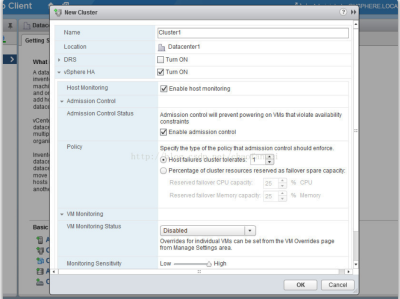https://www.cnuu.net/os/vmware/%E8%B7%A8vcenter%E8%99%9A%E6%8B%9F%E6%9C%BA%E8%BF%81%E7%A7%BB%E5%B7%A5%E5%85%B7-cross-vcenter-workload-migration-utility.html
此实用程序允许用户使用跨vCenter vMotion功能,从vCenter服务器之间的图形用户界面轻松批量迁移虚拟机。
This utility allows users to easily migrate virtual machines in bulk from a graphical user interface between vCenter servers using the Cross-vCenter vMotion feature.
Key Features
Completely UI-driven workflow for VM migration through a vSphere Client plugin and a standalone UI
Provides REST API for automating migration tasks
Works with vCenter Servers in the same or in different SSO domains
Supports migration to/from VMware Cloud on AWS
Enables batch migration of multiple VMs in parallel
Integrates with the host/cluster/resource pool menu of the vSphere Client inventory tree
Auto-populates inventory for ease of management
Monitor workload migration progress through vCenter Server tasks
Register sites to store vCenter Server information
Supported Operations
Perform live/cold migration as well as relocate/clone operations
Works for migration tasks within and across vCenter servers
Select host/cluster/folder/resource pool as placement target
Supports both storage vMotion and shared datastore migration
Flexible configuration for VMs with multiple network interfaces
要求:vCenter Server 6.0 Update 3或更高版本 & Java Runtime Environment 1.8-10
REQUIREMENTS
vCenter Server 6.0 Update 3 or above (ESXi hosts must also be 6.0u3+
Java Runtime Environment 1.8-10
Web Browser
Please review https://kb.vmware.com/kb/2106952 for Cross vCenter vMotion requirements
下载地址:
1. https://wwi.lanzoul.com/irayc00769ad
2. https://flings.vmware.com/cross-vcenter-workload-migration-utility
使用方法:
下载vmx-3.1.jar并安装java环境,可运行于windows或linux环境
启动方法:
$ java -jar xvm-3.0.jar
![图片[1]-跨vCenter虚拟机迁移工具 - Cross vCenter Workload Migration Utility](https://kinber.cn/zb_users/upload/2023/01/20230110091003_97848.png)
默认启动端口为8443,启动完成后通过浏览器访问https://IP:8443即可
修改默认启动端口:
$ java -jar -Dserver.port=31000 xvm-3.0.jar
打开浏览器界面如下:
![图片[2]-跨vCenter虚拟机迁移工具 - Cross vCenter Workload Migration Utility](https://kinber.cn/zb_users/upload/2023/01/20230110091003_61639.png)
输入vCenter的地址及账号密码
![图片[3]-跨vCenter虚拟机迁移工具 - Cross vCenter Workload Migration Utility](https://kinber.cn/zb_users/upload/2023/01/20230110091003_59954.png)
![图片[4]-跨vCenter虚拟机迁移工具 - Cross vCenter Workload Migration Utility](https://kinber.cn/zb_users/upload/2023/01/20230110091004_56052.png)
注意:必要条件,需要迁移的虚拟机所在的ESXI主机与所选择的目标ESXI主机之间的vMotion网络必须可以互通,否则无法进行迁移!
优势:可以实现将虚拟机跨vCenter在线热迁移,虚拟机无需停机,业务不受影响,并且迁移基于vMotion网络相对安全可靠。
INSTRUCTIONS
Run the utility jar file from a shell window. To use the plugin UI add the details of the vCenter Server 6.7U1+ which will be used to access the vSphere Client.
Java 8:$ java -jar xvm-3.0.jar –vcenter.fqdn=VCENTER-IP-OR-FQDN –vcenter.user=ADMIN-USER –vcenter.pass=ADMIN-PASSWORDJava 9/10:java –add-modules java.se.ee -jar xvm-3.0.jarDefault app port is 8443 which can be changed (e.g., 31000) by providing an additional flag:$ java -jar -Dserver.port=31000 xvm-3.0.jarNote: If you wish to just use the standalone client, you can simply omit the vCenter Server registration and then access the standalone UI using http://localhost: (default port 8443)$ java -jar xvm-3.0.jarAccess the UI of the utility
To use the plugin go to https://VCENTER-IP-OR-FQDN/ui in the browser and login.
To use the standalone UI (deprecated) connect to the app from the browser by using IP address/hostname of the machine (127.0.0.1 for localhost) where the utility is running as ‘host’
https://<host>:<port>Register vCenter servers for migration operations
from ‘vCenter Servers List’ view of the plugin
from ‘Register’ tab of the standalone UI. Provide required parameters:Sitename: a name to identify the vCenter server vCenter Hostname/IP address, username, password Trust server: select to skip SSL certificate verification during VC connection After a restart of the utility, enter password and re-establish connection for previously registered sites.
Initiate VM migration operations
from the vSphere Client plugin For experience integrated with the inventory tree use the ‘Import VMs’ action on a selected target Host or Cluster. For the general source-to-target scenario use the ‘Migrate VMs’ wizard from ‘vCenter Servers List’ view.
from the ‘Migrate’ tab of the standalone UI. Progress of migration tasks can be monitored on the home page. Provide required parameters (select values from menu):
Operation type: supported operations are relocate/clone Source and target sites: select sites from already registered sites Source VMs: select datacenter and VMs from the source site for migration Placement target: select target compute resource (host or cluster) Target datastore: select target datastore for placement Network mappings: select networks to map from source to target sites (Optional) Target pool and folder: select target VM folder/resource pool
本文链接:https://kinber.cn/post/3493.html 转载需授权!
推荐本站淘宝优惠价购买喜欢的宝贝:

 支付宝微信扫一扫,打赏作者吧~
支付宝微信扫一扫,打赏作者吧~


